A decade has passed since an Australian force took part in a United Nations task force to provide protection to humanitarian aid in civil war ravaged Somalia. This operation was one of the most significant since Australian Defence Force (ADF) involvement in multinational peacekeeping commenced with the contribution, in 1947, of military observers to what was initially titled the United Nations Good Offices Commission.
First UN Operation in Somalia (UNOSOMI) 1992-1993
Strength: 30 ADF Movement Controllers
In late 1990 and throughout 1991, Somalia collapsed into clan warfare and then civil war. As 1992 progressed the civil war worsened and the country effectively ceased to function as an organised nation state. Mass starvation and anarchy followed. Beginning tentatively in September 1992, the UN stepped in to protect the delivery of humanitarian assistance and to reconstitute Somalia as a functioning political, social and economic entity.
On 20 October 1992, the 30 Strong ADF Movement Control Unit (MCU) arrived in Somalia to assist UNOSOM I cope with the influx of assigned forces.
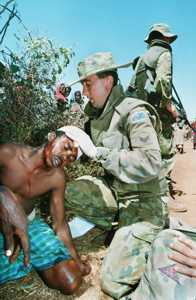
AWM MSU/93/0027/10. An Australian soldier provides assistance to a Somali who was injured in an axe fight during food distribution to the village of Sahmandeera.
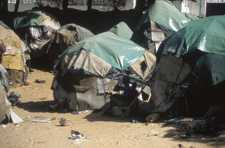
AWM P01735.050. Mogadishu. Makeshift housing made from recycled packaging material. Most of these small squat dwellings have a square of plastic as a roof for protection from the elements.
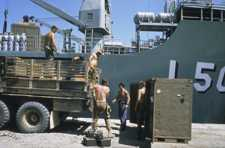
AWM P01735.117. Mogadishu. Sailors from HMAS Tobruk unload goods beside the ship tied up at the wharf. The Tobruk was support vessel for the Australian contingent to the Unified Task Force in Somalia (UNITAF).
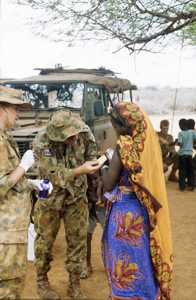
AWM P01907.007. A Somalian woman holding a baby whilst it is inoculated by two soldiers at an outdoor immunisation clinic.
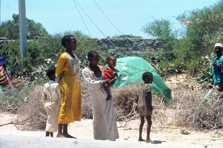
AWM P01735.070. Mogadishu. Somali children beside a makeshift dwelling made from recycled packaging material.
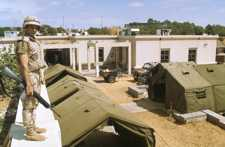
AWM P01907.001. Mogadishu. The Headquarters of the Australian Forces Somalia. In the foreground a soldier stands guard above the tent lines within the compound.
Unified Task Force in Somalia (UNITAF): 1992-1993
(Operation Solace) Strength: Approx 1,200. 1 RAR (Royal Australian Regiment) Battalion Group, Australian HQ and HMAS Tobruk.
By late 1992, the catastrophic situation in Somalia had outstripped the UN’s ability to quickly restore peace and stability, mainly because the UN was hamstrung by insufficient forces and UN peacekeeping principles and methods could not cope with the need to use force in such complex situations. On 3 December 1992, UN Security Council Resolution 794 authorised a coalition of UN members led by the US to form UNITAF and intervene to protect the delivery of humanitarian assistance and restore peace.
Australia deployed a battalion plus supporting elements, including a squadron of armoured personnel carriers, HQ staff, engineers, communications and electronic warfare specialists, administrative elements and HMAS Tobruk. The RAAF was also used to move the Australian forces to and from the area of operations, and conducted regular resupply missions from Australia . The battalion group operated the 17,000 square kilometre Baidoa Humanitarian Relief Sector in south-western Somalia.
The battalion group was very successful at fostering and protecting humanitarian relief efforts and won widespread international praise for its efforts in restoring law and order and re-establishing functional legal, social and economic systems.
On 2 April 1993, Lance Corporal Shannon McAliney, Royal Australian Infantry, was accidentally shot dead while on patrol during these operations.
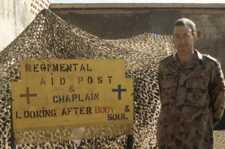
AWM P01735.388. Baidoa. The chaplain standing beside the regimental aid post and chaplain sign in the courtyard of the building used as headquarters by the 1st Battalion, the Royal Australian Regiment (1RAR).
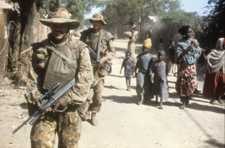
AWM P01735.402. Baidoa. Private Graeme M. (Brownie) Brown, an Aboriginal member of 2 Platoon, A Company, 1RAR, and another member of the Company on foot patrol in a street of the town.
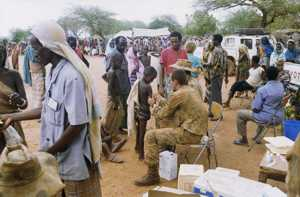
AWM P01907.008. Two soldiers inoculating a Somalian child at an outdoor immunisation clinic.
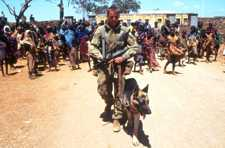
AWM P01735.485. Baidoa. A member of 3 Combat Engineer Regiment using one of their three dogs during a foot patrol through the native quarter. He is being watched by a large crowd of Somalis.
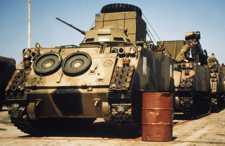
AWM P01914.009. Mogadishu. Armoured personnel carriers (APCs) bound for Baidoa. They have just been unloaded from the RAN heavy landing ship HMAS Tobruk.
Second UN Operation in Somalia (UNOSOMII) 1993-1996
Strength: 36 Movements and Air Traffic Control Staff, 12 man Ready Reaction Security Team (mainly SAS) and some HQ staff -- some 50 personnel per tour of duty-totalling approx 250.
On 5 May 1993, UNITAF handed over to a reinforced UNOSOM II. The Australian Battalion Group withdrew to Australia. The ADF Contingent provided movement control, air traffic control, some HQ staff and a ready reaction security team (mainly SAS) at the Mogadishu airport.
The Australian force was withdrawn in 1996.
Editor’s Note: Somalia today is a very different place from the Somalia seen by the Australians in 1993.The chaos that followed the massive UNBOSOM intervention has been replaced by security and stability in the north of the country and glimmers of hope for peace in the central and southern areas.
The most vulnerable populations in the conflict-prone southern areas of Somalia continue to receive help such as emergency food aid, international disaster assistance, vaccinations to prevent or impede epidemics, rehabilitation of health clinics and delivery of medicines, rehabilitation of wells and boreholes, distribution of seed and tools, and community based food aid project to rehabilitate irrigation canals and roads.
In 2001, the Integrated Strategic Plan for Somalia set the goal: ‘A more secure, less vulnerable Somalia in transition towards sustainable development’. (Source of information—USAID in Africa)
Reproduced with the kind permission of the Australian Peacekeepers and Peacemakers Association





